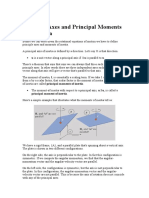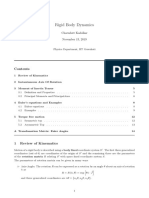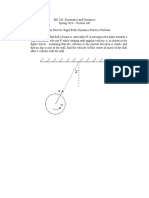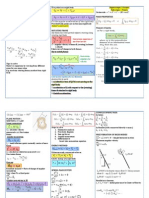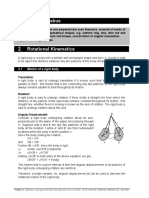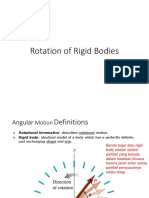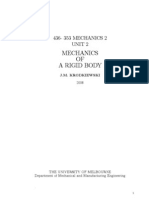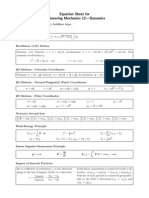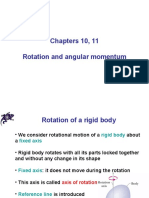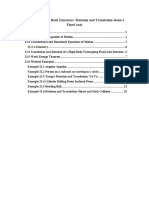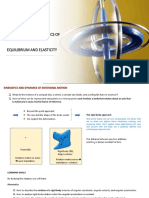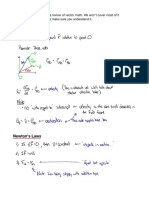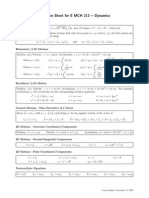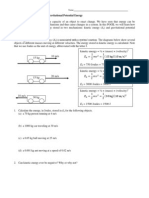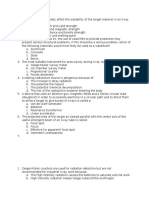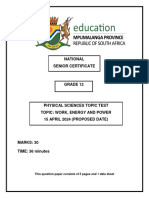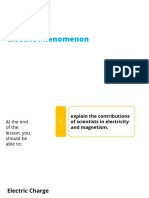SPA5304 Physical Dynamics Lecture 19
David Vegh
(figures by Masaki Shigemori)
26 February 2019
1 Rigid bodies
1.1 Parallel axis theorem
If the axis n̂2 goes through the center of mass, then the moment of inertia about another parallel axes n̂1 is
given by
In̂1 = In̂2 + M a2
where M is the total mass of the rigid body and a is the distance between the two axes.
1.1.1 An example: the rod
• If O0 is at the end of the rod:
M l3
3 0 0
IO0 = 0
M l3
3 0
0 0 0
• If O0 is at the center-of-mass:
M l3
12 0 0
ICOM = 0
M l3
12 0
0 0 0
1
� We have shifted the axis by a = l/2:
� �2
O 0
COM l
Ixx = Ixx +m
2
� �2
O 0
COM l
Iyy = Iyy +m
2
0
O COM
Izz = Izz
Rotation about ẑ is not affected.
1.2 Angular momentum
The fundamental formula of rigid kinematics:
ρ ~˙ + ω
~˙ i = R ~ × ~ri
The angular momentum about O is
~˙ + ω
X X
~O =
L ρ ~˙ i =
~ i × mi ρ ~ + ~ri ) × mi (R
(R ~ × ~ri )
i i
~˙ + R ~˙ +
X X X X
~×
=R mi R ~ × (~
ω× mi~ri ) + ( mi~ri ) × R mi~ri × (~
ω × ~ri )
i i i i
Let us take O0 = COM . Then
P
i mi~
ri = 0 and we get
~˙ +
X
~O = R
L ~ × MR mi~ri × (~
ω × ~ri )
i
Now using the formula
~ × (B
A ~ × C)
~ = (A
~ · C)
~ B~ − (A
~ · B)
~ C~
~=C
with A ~ = ~ri and B
~ =ω
~,
~˙ +
X
~O = R
~ × MR mi ~ri2 ω
�
L ~ − (~ri · ω
~ )~ri
i
2
�The second term can be written as X
mi ~ri2 δab − ria rib ωb
�
i
| {z }
ICOM
Here a, b are vector indices. Thus,
~O = R
L ~˙ + ICOM ω
~ × MR ~
| {z }
~ COM
L
Compare this with our earlier formula for the angular momentum of a system of particles:
~ =R
L ~˙ + L
~ × MR ~0
~ 0 , i.e. the angular momentum with respect to the COM (“spin part”)
We see that LCOM is nothing but L
1.3 ~
Kinetic energy in terms of L
• Recall that for O0 = COM ,
1 ~˙ 2 1
T = M R + ω · ICOM ω
~
2 2 | {z }
~ COM
L
Thus
1 ~˙ 2 1 ~ COM
T = MR + ω · L
2 2
• For a fixed O0 we have
1
~ · IO0 ω
T =
ω ~
2
Since O0 is fixed, a point Pi in the rigid body has velocity
~r˙i = ω
~ × ~ri
Therefore, X X
~ O0 = mi ~ri2 ω
�
L ~ri × mi (~
ω × ~ri ) = ~ − (~ri · ω
~ )~ri = IO0 ω
~
i i
So we have
1 ~ O0
T = ~ ·L
ω
2
3
�2 Spinning Tops
0
O
Let us study a more general (3-dimensional) motion of rigid bodies. We immediately face a problem: Iab
is simple in the body-fixed (non-inertial) frame SII , but our formulation has been about an inertial frame
(e.g. SI ). We need to find awa to describe dynamics in the body-fixed frame.
2.1 Rotating frame
Consider some general vector ~u. If it is not changing in the moving frame SII , its rate of change is due only
to the rotation of the frame
d~u
=ω~ × ~u
dt
More generally, if ~u is changing in the moving frame,
d~u d0 ~u
= ~ × ~u
+ω
dt dt
|{z}
change w.r.t.
the moving frame SII
Let us make this derivation more precise.
Take bases for frames SI and SII :
SI : ~e(a) a = 1, 2, 3 (fixed)
SII : f~(a) a = 1, 2, 3 (moving)
A general vector ~u can be expanded as
~u = uIa~e(a) = uII ~(a)
a f
where uIa and uII
a are the components in SI and SII , respectively.
4
� The time-derivative is
~u˙ = u̇Ia~e(a) = u̇II ~(a) + uII f~˙(a)
a f a
Since SII is rotating with angular velocity ω
~,
˙
f~(a) = ω
~ × f~(a)
and thus
d~u
~u˙ = = u̇II f~(a) + ω
~ × uII f~(a)
dt | a {z } | a {z }
d0 u
~ ~
u
dt
If we define
uII
1
~uII = uII
2
: components in SII
II
u3
Then
~u˙ = ~u˙ II + ω
~ II × ~uII
|{z}
d
dt of components in SII
We succeeded in expressing dynamics in terms of quantities in the moving frame SII .
2.2 Euler equations
Recall: X
~ =
L ~ri × mi~r˙i
i
~˙ = (e)
X
L ~ri × F~i
i
In particular, for angular momentum about the COM,
~˙ COM = (torque about COM) ≡ K
L ~
From the above formula,
~˙ COM,II + ω
L ~ COM,II = K
~ II × L ~ II
~ COM = ICOM ω
We know that L ~.
If we take SII to be a principal axis system, then we get
I1 ω1II
~ COM,II
L = I2 ω2II
I3 ω3II
Furthermore,
ω1II I1 ω1II (I3 − I2 )ω2II ω3II
~ COM,II
~ II × L
ω = ω2II × I2 ω2II = (I1 − I3 )ω1II ω3II
ω3II I3 ω3II (I2 − I1 )ω1II ω2II
5
� Thus we have obtained the Euler equations
I1 ω̇1 + (I3 − I2 )ω2 ω3 = K1
I2 ω̇2 + (I1 − I3 )ω3 ω1 = K2
I3 ω̇3 + (I2 − I1 )ω1 ω2 = K3
Here the index II has been suppressed on ω and K.
• These are non-linear differential equations.
~ in the body-fixed frame with O0 = COM .
• They describe the motion of ω
The axis about which the rigid body rotates keeps changing in the body-fixed frame.



